
Renovation works to completely revamp Halls 10-14, called the Botticelli rooms, have just been completed and a reopening of the Botticelli halls is planned for Tuesday, October 18th. A whole new setting and exposition of the works has been projected.
Over the next weeks, the work of preparing the room for the return of the works will be be completed. The entire renovation works of these halls, and Hall 41 where Botticelli’s Spring and Birth of Venus have been admired by over 2 million visitors over the last year, were funded by the non-profit organization Friends of Florence.
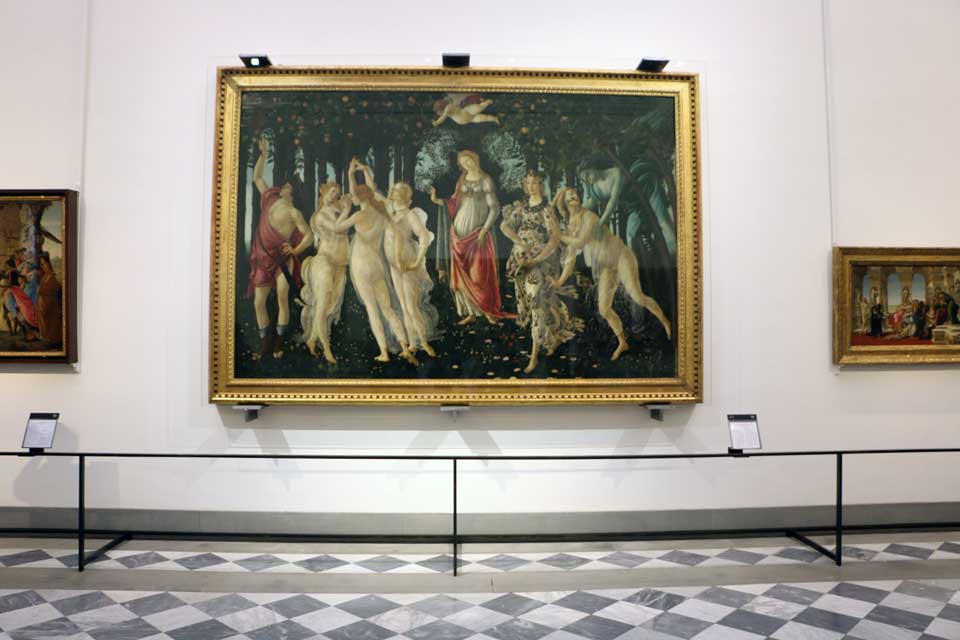
The Uffizi Gallery just announced that it will have a special opening on MONDAY, August 15th, day of the week when the museum is usually closed and this year also a national holiday. On “ferragosto”, the museum will be open with normal hours, from 8.15am to 6.50pm. Last entry that can be reserved will be at 4.45pm.
The opening was just announced after the museum leadership reached an agreement for the opening with staff union representatives.
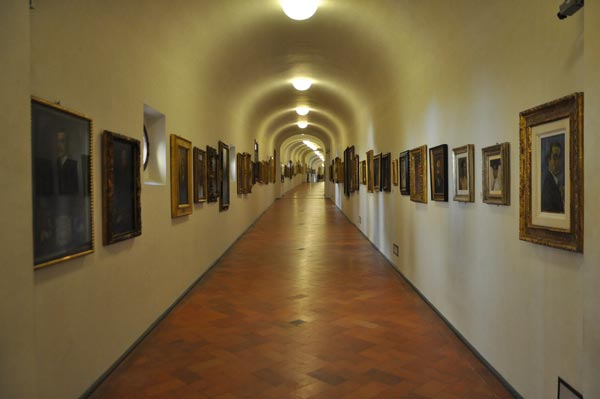
News just sent out by the director’s office of the Gallerie degli Uffizi is that the Vasari Corridor is, effective immediately, closed to visits to all groups. This after an order by the Provincial Command of the Fire Department was issued after an on-site visit by officials of the Fire Department to ascertain the security conditions of the corridor. Details as to what exactly was found lacking were not provided in the news release by the museum.

Up until September 27th, the Uffizi Gallery has organized longer openings hours every Tuesday while it offers a Festival of the Performing Arts called “Uffizi Live“.
The summer festival includes theater, dance and musical shows and concerts within the Uffizi’s rooms between 7pm and 10pm on these Tuesdays.
Visitors will thus have an extra plus to their evening visit at the museum on these days, having a chance to enjoy the pictorial and sculptural artworks of the museum along with other forms of art. The shows range from traditional performances to more contemporary and experimental shows.
(Above you see the Versiliadanza Ensemble who performed on June 14th an itinerant piece of contemporary dance across the rooms of the Gallery.)

On June 28th, the actress Stefania Stefanin, accompanied by the musical notes of Emma Nicoletti’s violin, re-evoked the Ovidian myth of Niobe and the massacre of her children, the Niobids, in the Hall of the Niobe.
The live performances are included with your museum ticket to the Uffizi and should transform a simple visit to the Uffizi into an extra special visit! Check out the program for July below (program for August and September should be released toward the end of the previous month):
Tuesday, July 5th:
The first Tuesday of July will offer a fascinating concert of medieval music and singing. The San Felice Ensemble, composed of five musicians and two singers under the direction of Maestro Federico Bardazzi, will play a selection of sacred and profane pieces of laude and contrafacta written by Francesco Landini, a Florentine composer and musician of the 14th century.
Tuesday, July 12th:
A double show for Uffizi visitors: a classical music concert and a theatrical performance inspired by the “mimic” method. In the Niobe Room, the young Stefania Scapin plays a solo harp piece directed by Maestro Michele Sarti called “Between Bach and Scarlatti”. Meanwhile, across the various rooms of the museum, actors from the Down Theatre Company will bring artworks to life by using mime movements, inspired by the acting method of the great Master of Drama, Orazio Costa.

Tuesday, July 19th:
The Antica Liuteria Sangineto presents “The depicted sound – musical instruments in the art of painting”, a project that mixes music and art history. The artisans of the Sangineto family will display the faithful reconstructions of ancient string instruments they have handcrafted by copying the original ones featured in paintings within the Gallery. The instruments will thus “relive” and play again, each one next to its depicted replica.
Tuesday, July 26th:
July ends with an original and unusual show: a performance of illusion and magic expressly conceived for the artworks of the Uffizi Gallery by Bustric, the Magician. Disguised as an odd night attendant of the museum, Bustric will talk about the artworks while accompanying visitors in a colorful, poetic itinerant tour through the rooms of the Uffizi Gallery.
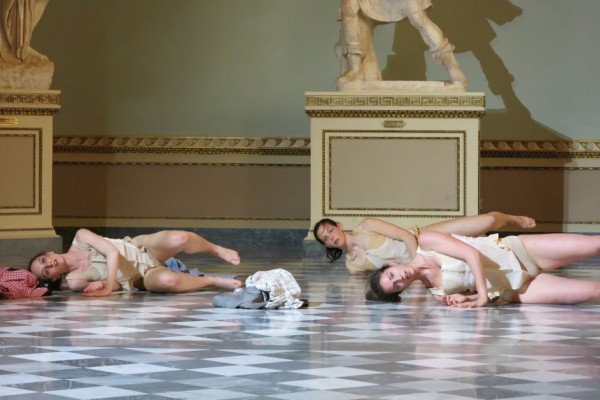
Company Blu inaugurated the season on the last Tuesday in May with a contemporary dance performance entitled “4 Steps 4 Angel” by Charlotte Zerbey in the Niobe room.

Have you seen that the Uffizi is currently hosting the exhibition dedicated to painted wooden sculpture of the 15th century, called “He Made Sculpture out of Wood and Colored It”? Make sure you stop by during your visit, because it is really quite breathtaking!
In addition to a simple stop, if you’re at the museum on Thursdays, you could join in on a guided visit to the exhibit. Every Thursday, in fact, the museum is offering 2 guided visits, at 2pm and 4:30pm. The visits are free with paid admission.
All you need to show up at the entrance to the exhibit (at Hall 83 on the first floor) about 10 minutes before. Groups of up to 15 people will then be led into the exhibit together. You can book your spot by calling 055.238.8693 between Tuesday and Saturday, 2:30-4:30pm.
If you miss the guided visits, don’t worry but don’t skip the exhibit! It is a once in a lifetime opportunity to see some works up close before they head back to churches and altars.
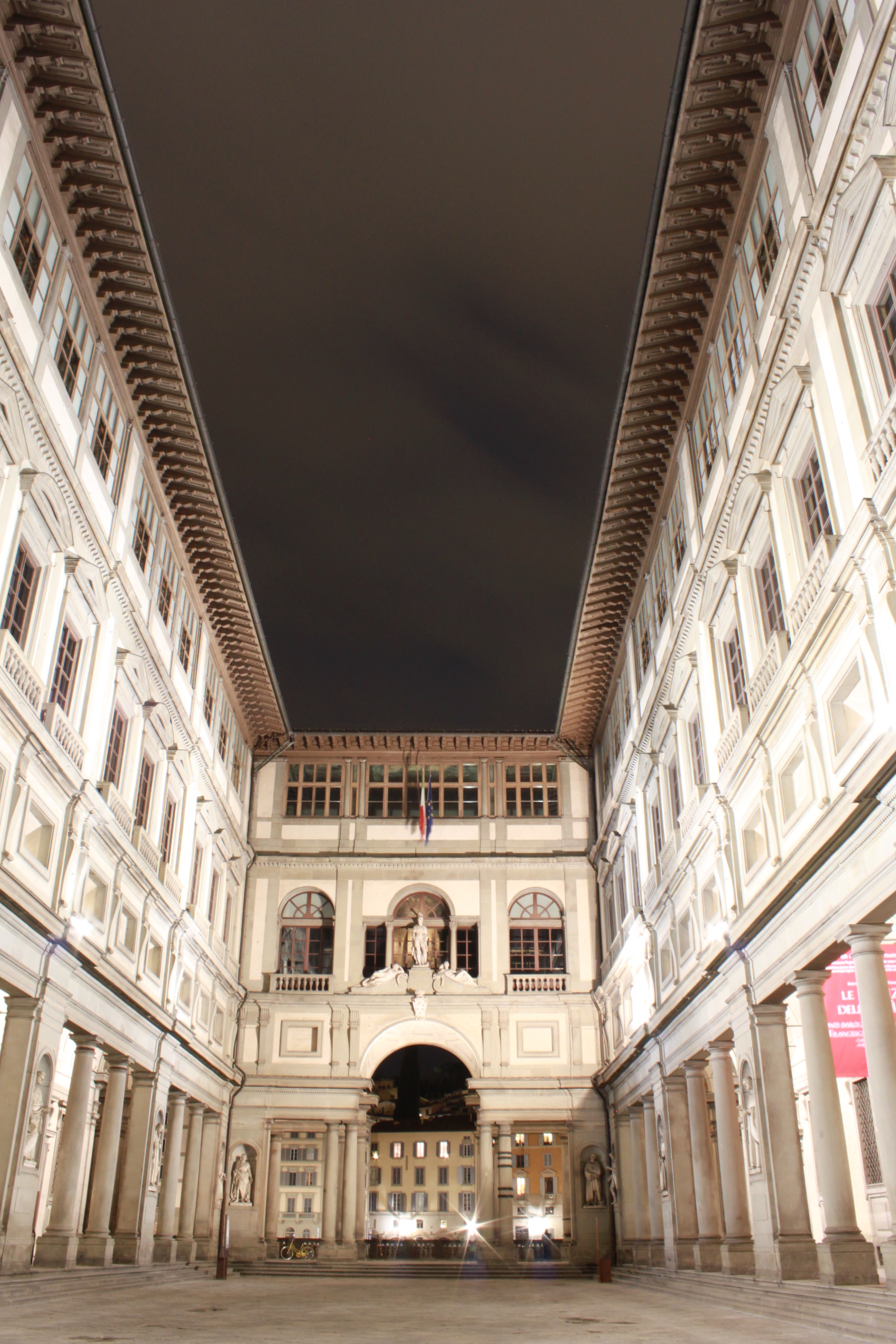
On Saturday, May 21st, the Uffizi Gallery will participate in the Europe-wide initiative of “Night at the Museum” and have a special opening in the evening, staying open from 7 to 10pm.
Entrance will be a symbolic 1 euro (except for cases in which entrance is free). Note that it will not be possible to book entrance ahead of time for these hours.

Starting May 31st and continuing through the summer until September 27th 2016, the Uffizi Gallery will have prolonged opening hours every Tuesday evening. From 7pm until 10pm, the museum will also organize special events connected to works of art in the museum for these special openings which will include music, literature, dance or theater. A detailed program should be available in the next few weeks and we look forward to sharing it with you.
EDIT: Here’s the program for July and for August.
Entrance into the museum during these extra hours will be paid admission, you will be able to book by phone (+39-055-294-883) or online – check the info on this page for more details. The last available time that can be pre-booked is 8pm but you can just head directly to the museum to enter at a later time.
Happy summer visits to the museum!

The Uffizi Gallery has just announced that it will have two special openings on Mondays coming up. The first is on Monday, April 25th, on Italy’s National Liberation Day (a national holiday). The second is on Monday, May 2nd.
Opening hours will follow normal times, from 8.15am to 6.50pm.
The museum will be CLOSED on Sunday, May 1st.
The Boboli Gardens will have a special opening on May 1st from 8:15am to 6:30.

The special opening on Easter Monday for the Uffizi Gallery has been confirmed for March 28, 2016. The museum will also be open on Easter Sunday.
The Uffizi will be open on both days from 8.15am to 6.50pm.
In addition, the Boboli Gardens, Silver Museum and Costume Gallery, all part of the Pitti Palace museum complex will also be open on Easter Sunday and have special opening on Easter Monday from 8:15am-6:30pm.
You can book your tickets for the Uffizi ahead of time to avoid long queues at the ticket entrance. Check our page on how to book your tickets for more details!

New director for the Galleries of the Uffizi, Eike Schmidt, has offered remarks on his proposed plans for opening the Vasari Corridor to the general public and moving the self-portrait collection from the Corridor, in order to answer doubts raised about the plans for the Vasari Corridor.
First, you should know that the Vasari Corridor, the 16th century elevated and enclosed hallway that connects the Uffizi Gallery to Palazzo Pitti, is generally closed to the public. There were a few special openings a few years ago offered by the museum, and these were sold out in a matter of weeks. So the interest to visit the Corridor has been, and remains, high and this is likely because it is generally closed so a visit seems to be special.
The Corridor hosts one of the largest and oldest collection of self-portraits of artists from the past centuries. The proposal would be to move it into the Uffizi Gallery.
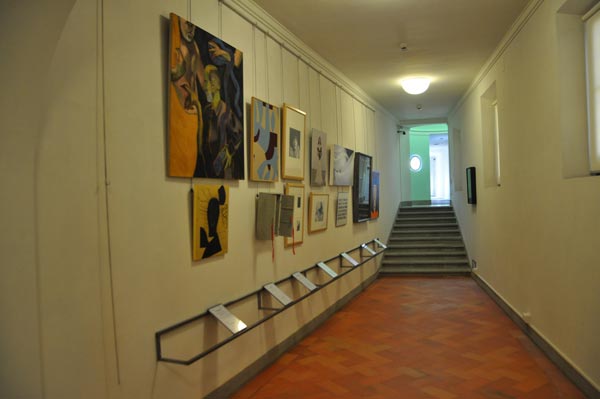
The museum today only opens the Vasari Corridor to tour operators and travel agencies who organized the groups and requests “a special opening” of the corridor. The groups are limited to a maximum of 25 people given the width of the Corridor and the necessity of having museum personnel accompany each group. This has allowed the Corridor to be visited, making the visit quite “exclusive” for those who have planned it into their visits to Florence.
Schmidt’s proposed plans would be to eliminate this privilege, offering a Vasari Corridor tour from the Uffizi Gallery to the Pitti Palace with its own entrance ticket (separate from the Uffizi) at an affordable cost (the visit with tour agencies starts at 45 euro and up per person).
There are some organizational problems to deal with: the tour is one-way, so what if you leave a backpack or umbrella checked at the cloakroom at the Uffizi? You can’t get back in to the museum to retrieve them, so Schmidt proposes that as long visitors are advised of this ahead of time, they will know to not bring along any backpacks or umbrellas that need to be checked in and thus eliminate the concern completely.

Others have raised the question of foot traffic: Schmidt says “to remain calm: during the time it takes to cross the Corridor, about a kilometer long, the impact of the weight of the group is never concentrated in one point as is the case, for example, in the Botticelli Hall within the Uffizi Gallery, where groups collect and remain for a while.”
What about the self-portrait collection? First of all, Schmidt reminds all of us, the self-portrait collection was placed along the Corridor only in modern times. The collection, started by Cardinal Leopold de’ Medici was always kept within the Uffizi, in the “Hall of Painters” (the current hall 35 that is dedicated to Michelangelo). This hall was taken apart in the 19th century and the collection kept in the deposits until 1973, when the then-director of the Uffizi Luciano Berti placed it the Vasari Corridor. So its rightful place, actually, would be for it to return within the Uffizi Gallery.
In addition, Schmidt adds, the tour from the Uffizi to the Pitti is generally completed in about 45 minutes so “almost at a run”. It is hardly possible to stop and really admire the collection, other than to stop in front of some of the more celebrated works of art. Within the Uffizi, visitors will be able to admire them with calm. Where they will be placed is yet to be determined.

The biggest concern motivating the move of the collection is actually the most important, in my opinion. The Vasari Corridor was not made and is not furnished with any temperature control system. It is exposed to the sun and wind and thus experiences extreme hot and cold through the seasons. This environment is NOT adequate to conserve centuries old paintings made on canvas and wood. The proposal of installing a temperature-control system is also impractical, as it would mean altering the historical architectural structure of the Corridor.
The proposal would be to place within works made out of materials that would withstand, by their very nature, the atmosphere of the Corridor, such as the frescoes detached from the outside of the Corridor itself and which have been in the gallery’s deposits for decades.
At this point, a last change would be to update the type of lighting within to make it more pleasant and adequate for the space. At the very end of “this profound change, the Vasari Corridor will be anything but a highway”, as some have criticized. Above all, the “Prince’s Route” will remain a privileged path given the unique view it offers on the city, the hills and the river but it will finally be open to the public following the spirit of the inheritance Anna Maria Luisa de’ Medici left to the city: the Medici collections left to the city “as an ornament of the State, for the Public Good and to attract the curiosity of Foreigners”.
We applaud Director Schmidt’s plans and remarks on the plans for the future of the Vasari Corridor. We hope that all of these changes are made in the shortest time possible so that the Corridor can be open to all soon.










